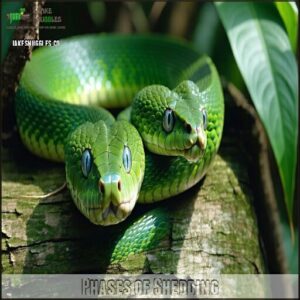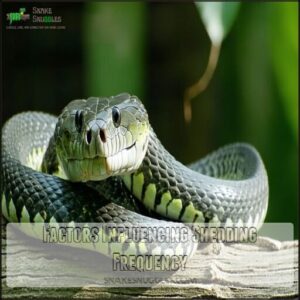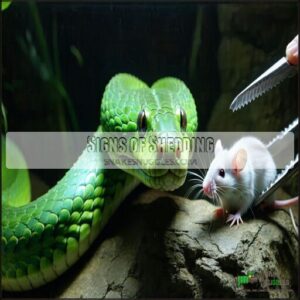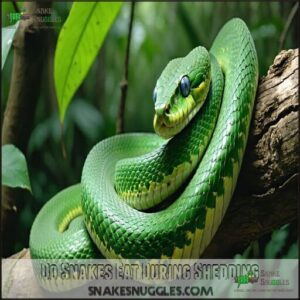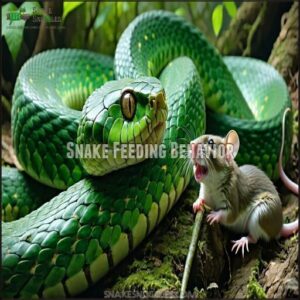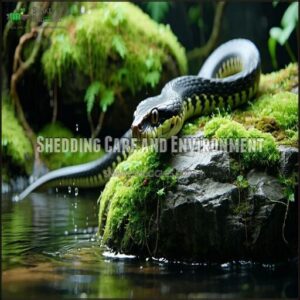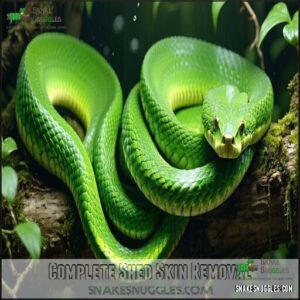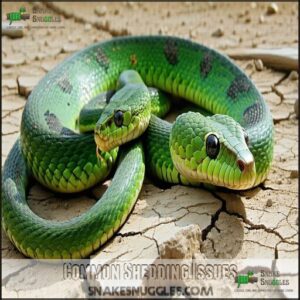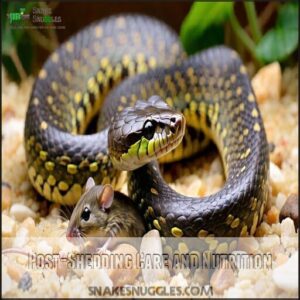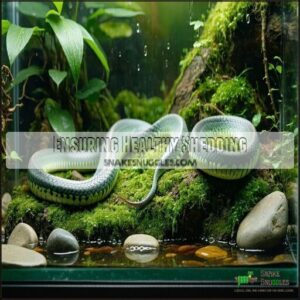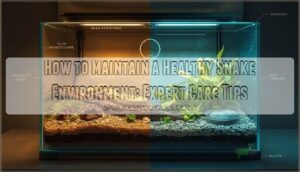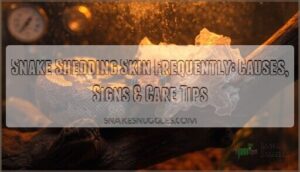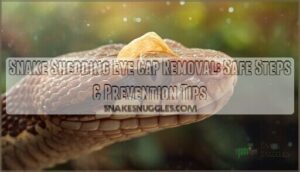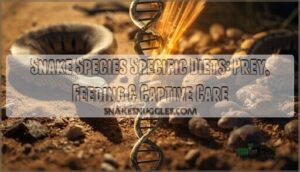This site is supported by our readers. We may earn a commission, at no cost to you, if you purchase through links.
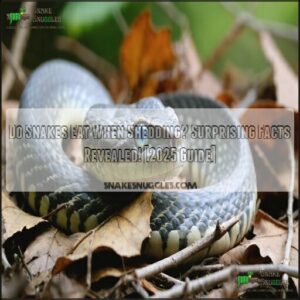
During this time, your snake’s vision becomes cloudy from the old skin covering their eyes (called "blue phase"), making them feel vulnerable and less likely to hunt.
Their digestive system also slows down as their body focuses energy on creating new skin.
You’ll notice your snake refusing food 1-2 weeks before shedding begins, which isn’t cause for concern—it’s completely natural, like how you might skip a meal when you’re not feeling your best.
Once they’ve completed their shed, your snake’s appetite will return with a vengeance, often ready for a larger meal than usual.
Table Of Contents
- Key Takeaways
- Snakes Shedding Process
- Do Snakes Eat During Shedding
- Snake Feeding Behavior
- Shedding Care and Environment
- Signs of Successful Shedding
- Common Shedding Issues
- Post-Shedding Care and Nutrition
- Ensuring Healthy Shedding
- Frequently Asked Questions (FAQs)
- Do snakes stop eating during shedding?
- Should you handle a snake after it has shed?
- Do snakes eat shed skin?
- Why do snakes shed their skin?
- How long does it take a snake to shed?
- Why does a king snake eat a shed?
- Can shedding impact a snakes digestion?
- How do wild snakes shedding habits differ?
- Can medications affect shedding and appetite?
- Do nocturnal species shed differently?
- Conclusion
Key Takeaways
- Most snakes don’t eat during shedding because their vision becomes cloudy from the "blue phase," making them feel vulnerable and less likely to hunt.
- You’ll notice your snake refusing food 1-2 weeks before shedding begins as their digestive system slows down to focus energy on creating new skin.
- After completing their shed, your snake’s appetite will return quickly—often with increased hunger due to the energy expended during the shedding process.
- You should maintain proper humidity (50-70%) and minimize handling during shedding to reduce stress and ensure a healthy, complete shed.
Snakes Shedding Process
You’ll notice your snake’s skin turning bluish and its eyes clouding over as it begins the natural process of ecdysis, which occurs multiple times yearly to aid in skin rejuvenation and parasite removal.
During this one-to-two-week period, your snake will likely hide more and stop eating as its impaired vision and physical discomfort make it focus entirely on successfully shedding its entire skin from head to tail, a process that aids in skin rejuvenation and parasite removal.
During shedding, your snake retreats into itself – impaired vision and discomfort drive it to focus solely on renewal.
Phases of Shedding
How does a snake’s body prepare for a new skin?
The shedding process, known as ecdysis, occurs in four distinct phases.
First comes premolt, when your snake’s skin dulls and eyes cloud over.
Next is the clearing stage, where eyes become clear again.
Then actual shedding begins, typically starting at the head.
Finally, the postshed phase reveals fresh, vibrant skin.
During this cycle, appetite loss is normal snake shedding behavior.
Factors Influencing Shedding Frequency
While many factors affect snake shedding frequency, age is the primary influence.
Young snakes shed more often—sometimes monthly—due to their rapid growth rate.
Species variation plays a significant role too; some snakes shed 4-6 times yearly, while others shed up to 12 times annually.
Health status, environmental factors, and stress can all alter your snake’s normal shedding pattern, which is also influenced by species variation.
Signs of Shedding
Spotting the telltale signs of an upcoming shed will help you provide better care for your snake.
You’ll notice several distinctive changes in your pet’s appearance and behavior:
- Dull skin replacing their usual vibrant colors
- Cloudy or bluish eyes due to impaired vision
- Increased hiding behavior and general reluctance to be handled
- Noticeable refusal to eat, sometimes for several days
Most snakes also become more irritable during this stressful time.
Do Snakes Eat During Shedding
Most snakes take a break from their regular feeding schedule during shedding. The question of whether snakes eat when shedding isn’t straightforward—individual variation exists even within the same species.
Individual snakes dance to their own rhythm during shedding—some fast while others feast, even within the same species.
Generally, snakes experience a decreased shedding appetite as their bodies prioritize energy for the molting process rather than digestion. Your snake might display prey rejection for up to two weeks before and after shedding, which is completely normal behavior.
While some snakes will accept food if offered during this time, feeding risks include potential digestion issues and increased stress. The old skin doesn’t stretch properly when a snake eats, potentially causing an incomplete shed.
It’s best to wait until the shedding process completes before resuming your snake feeding routine. Temperature and stress levels also influence whether your snake will eat during this vulnerable period.
Snake Feeding Behavior
You’ll notice distinct changes in your snake’s feeding patterns during the shedding cycle, with most species naturally refusing food due to reduced sensory perception and physical discomfort.
After completing a shed, your snake will typically resume normal feeding behavior within one to two days, often showing increased hunger due to the energy expended during the shedding process, which can impact their overall physical discomfort.
Autophagy and Shed Skin Consumption
During the shedding process, you might witness your snake eating its own shed skin—a fascinating behavior called autophagy.
This isn’t just a quirky habit; it serves an evolutionary purpose through nutrient recovery.
Species variation exists; corn snakes sometimes indulge in this practice, while king snakes frequently consume their shed for digestive benefits.
This protein source supplements their diet, though the frequency of autophagy varies substantially between individual snakes.
Protein-Rich Diets for Healthy Shedding
Protein powerhouses support your snake’s shedding process, delivering essential nutrients for healthy skin regeneration. Your reptile’s dietary protein directly impacts both growth rate and shedding quality.
- Choose varied prey items to provide thorough nutritional needs
- Feed whole prey animals containing skin, bones, and organs
- Supplement with vitamin A for ideal skin health
- Match protein sources to your snake’s natural diet
- Increase protein slightly before expected shedding cycles to ensure healthy skin regeneration and a successful shed, which is crucial for your snake’s overall well-being.
Feeding Snakes After Shedding
After the shedding process completes, you’ll notice your snake is ready for a meal.
Most snakes are actually quite hungry once they’ve shed their skin.
You can offer food within 24-48 hours after shedding, starting with appropriate prey size based on your snake’s weight.
If your snake refuses food initially, try again in a few days—post-shed feeding habits can vary between individuals, and it’s essential to be patient and observe your snake’s unique behavior.
Shedding Care and Environment
You’ll need to create the right environment for your snake during shedding to guarantee this natural process happens smoothly.
Maintaining proper humidity levels, providing rough surfaces for rubbing, and minimizing handling will substantially reduce your snake’s stress and prevent common shedding complications.
Maintaining Proper Humidity
While snake feeding habits pause during ecdysis, humidity becomes your top priority.
You’ll need to maintain 50-70% humidity in your snake’s enclosure for smooth shedding success. Proper humidity monitoring with an accurate hydrometer is non-negotiable.
For accurate readings, consider that a reptile hydrometer accurate is essential.
Different species have varying needs – ball pythons require higher levels than corn snakes.
Regular enclosure misting creates the moisture balance that helps your snake shed its skin in one complete piece, which is crucial for smooth shedding and overall health, ensuring a successful ecdysis process.
Providing Rough Surfaces
To aid the shedding process, your snake needs to rub against textured items in its enclosure.
Set up rough surfaces like branches, rocks, or cork bark that provide the necessary friction for removing old skin without injury. These texture-rich materials are essential for shedding success and help prevent incomplete sheds.
Consider purchasing specialized shedding aids to further assist your snake.
Natural elements assist with the physical aspects of shedding and also encourage natural snake behavior.
Minimizing Handling and Stress
Your snake’s fragile state during shedding demands minimal interaction. Don’t handle your snake before, during, or after shedding to reduce snake shedding stress.
Secure hides provide necessary security while they’re vulnerable. If you must move them, use gentle interaction and keep handling frequency to an absolute minimum.
Safe enclosures with reduced disturbances help guarantee successful shedding—your snake will thank you by completing the process smoothly.
Maintaining proper humidity levels is also critical for a healthy shed, and following these practices ensures your snake’s well-being during this vulnerable time.
Signs of Successful Shedding
You’ll know your snake has shed successfully when the skin comes off in one complete piece, including the eye caps.
After a proper shed, your snake will quickly regain its appetite and resume normal activity levels.
Complete Shed Skin Removal
A successful snake shedding produces one intact piece resembling a ghostly outline of your pet.
You’ll want to inspect the shed carefully for completeness, looking for any retained pieces that could indicate health issues. The shed should include the eye caps and tail tip.
If parts remain stuck, a gentle soak method can help with complete removal.
Proper humidity levels are also essential for a healthy shed.
For persistent problems, seek veterinary care.
Eye Caps and Humidity Issues
After a successful shed, always check for retained eye caps – those translucent discs that should come off with the rest of the skin.
You’ll see clear, bright eyes when they’re properly shed.
Low humidity is often the culprit behind stuck eye caps.
Maintain 50-70% humidity in your snake’s enclosure to prevent dysecdysis.
For stubborn cases, a 10-15 minute soak can help, but veterinary intervention becomes necessary if eye caps remain after multiple sheds.
Post-Shedding Appetite and Activity
After a successful shed, you’ll notice a dramatic increase in your snake’s activity level.
They typically become hungry within 24-48 hours, keenly accepting their post-shed feeding.
Watch for increased movement and tongue flicking—clear signs they’re ready for nutrition.
Most snakes show strong prey preference and improved digestion during this period.
Maintain proper hydration needs while monitoring their weight to guarantee proper snake diet and recovery.
Common Shedding Issues
You’ll likely encounter issues like incomplete sheds or retained eye caps during your snake’s shedding process.
These problems often stem from inadequate humidity levels or underlying health conditions that require prompt attention to prevent further complications, and it’s crucial to address them with proper care.
Incomplete Sheds and Retained Eye Caps
Now that you know what successful shedding looks like, let’s examine when things go wrong.
Incomplete sheds (dysecdysis) happen when your snake can’t remove all its old skin in one piece.
Retained eye caps are particularly concerning complications that require careful attention.
- Low humidity levels often cause skin to stick, preventing proper removal
- Rough shedding surfaces like branches help snakes naturally remove stubborn patches
- Without veterinary intervention, retained eye caps can lead to serious infections and vision problems
Addressing Humidity and Health Issues
Now that you’ve identified retained eye caps or incomplete sheds, let’s address the underlying causes.
Proper humidity control is your main defense against shedding complications and skin infections. Monitor humidity levels with a hygrometer, aiming for species-appropriate ranges.
During shedding, increase humidity by misting the enclosure or providing a humid hide box. Balancing moisture prevents respiratory issues while supporting snake health through the vulnerable shedding period, which relies on proper humidity to prevent complications, and ultimately supports overall snake health.
Consulting a Veterinarian
While addressing humidity issues helps most shedding problems, some situations require professional help.
When should you consult a veterinarian about snake shedding complications?
- Multiple incomplete sheds despite humidity adjustments
- Persistent anorexia lasting more than 2-3 weeks after shedding
- Signs of skin infections like redness, swelling, or discharge
- Suspected parasite concerns affecting the shedding process
- Retained eye caps that don’t resolve with home treatments
Don’t wait until minor shedding abnormalities become serious health issues. Preventative care saves lives!
Post-Shedding Care and Nutrition
You’ll need to offer food to your snake within 24-48 hours after shedding when they’re typically at their hungriest and most receptive to feeding.
During this post-shedding period, you should monitor your snake’s weight and adjust prey size accordingly to support healthy growth and recovery from the energy-intensive shedding process.
Offering Food After Shedding
Your snake’s post-shed appetite is typically at its peak right after shedding.
You’ll want to offer food within 24-48 hours of a complete shed when their feeding instincts are sharpest.
Most snakes readily accept meals during this time as their prey recognition abilities return to normal.
If your snake rejects food, try again in a few days – their feeding schedule may need adjustment.
Choosing Prey Size and Type
Selecting the perfect prey for your recently shed snake is essential for proper nutrition. Your snake’s prey should match its widest body width to prevent regurgitation issues.
As your snake grows, you’ll need to adjust prey size accordingly. Understanding appropriate prey dimensions is imperative for successful feeding.
Frozen mice and rats are safer than live prey, which can injure your snake. Some species may have specific preferences, so research your particular snake’s natural diet for superior health.
Monitoring Snake Weight and Health
Beyond selecting the right prey, you’ll want to track your snake’s overall condition.
Regular weight checks reveal important health patterns.
Here’s what to monitor:
- Weight fluctuations of more than 10% between feedings
- Body condition score (1-5 scale with 3 being ideal)
- Hydration levels shown by skin elasticity
- Activity changes before and after shedding
Record these snake health indicators monthly to spot potential issues early.
Consistent monitoring helps identify potential skin abnormalities and is crucial for maintaining your snake’s overall health and detecting early signs of illness.
Ensuring Healthy Shedding
You’ll guarantee your snake sheds properly by maintaining ideal humidity levels (50-70%) and providing rough surfaces for them to rub against.
Minimize handling during the shedding process to reduce stress, as a calm environment with proper temperature control substantially improves your snake’s ability to shed its skin completely.
Avoiding Handling and Stress
Now that you’ve nourished your snake post-shedding, let’s focus on another critical aspect of their care.
During shedding, your snake needs peace. Reduce stress by keeping handling to an absolute minimum. Watch their behavior from a distance instead. When interaction is necessary, use gentle handling techniques.
Snake shedding is substantially impacted by stress, so create a quiet, secure space where they can shed undisturbed.
Maintaining proper humidity and temperature is also essential for a healthy shed. Your patience now guarantees healthy molting.
Providing a Suitable Environment
While minimizing stress is key, your snake’s habitat design plays an equally important role during shedding.
Create an enclosure with proper size, offering enough room to stretch but not too spacious to cause insecurity.
Choose substrate that retains moisture, like coconut fiber or cypress mulch.
Arrange multiple hiding places throughout the temperature gradient zones so your snake can select its comfort spot.
This thoughtful environment setup substantially improves shedding success, and by doing so, it helps in minimizing stress, which is key to a healthy snake.
Maintaining Optimal Temperature and Humidity
With your habitat properly set up, you’ll now want to dial in your temperature and humidity levels.
Snakes need specific conditions to shed successfully.
Keep humidity between 50-70% during shedding periods – higher than normal maintenance levels.
Create a temperature gradient (75-85°F warm side, 70-75°F cool side) so your snake can self-regulate.
Digital hygrometers and thermometers are worth every penny for accurate monitoring of these critical environmental factors.
Frequently Asked Questions (FAQs)
Do snakes stop eating during shedding?
While your eyes remain clear, your snake’s vision clouds over during shedding.
Yes, most snakes stop eating days before and during shedding due to stress, impaired vision, and physical discomfort.
They’ll resume eating afterward, which is an important point to consider for snakes that are shedding.
Should you handle a snake after it has shed?
Wait 1-2 days after shedding before handling your snake. It’s vulnerable with sensitive new skin during this time. Brief, gentle handling afterward is fine when your snake shows normal behavior.
Do snakes eat shed skin?
Some snake species do eat their shed skin through a behavior called autophagy.
You’ll notice this varies by species – corn snakes and king snakes commonly practice this, recycling nutrients from their discarded skin.
Why do snakes shed their skin?
Your body grows but your skin doesn’t, so you’d need a new one.
Snakes shed their skin to accommodate growth, remove parasites, and heal injuries.
It’s like getting a fresh new outfit.
How long does it take a snake to shed?
The full shedding process takes one to two weeks, with the actual skin removal lasting just a few hours to a couple of days.
You’ll notice your snake starting at the head and working downward.
Why does a king snake eat a shed?
King snakes eat their shed skin to recover nutrients and prevent predators from tracking them.
This behavior, called autophagy, isn’t universal among snakes but occurs frequently with king snakes due to their opportunistic feeding habits.
Can shedding impact a snakes digestion?
Like a car in maintenance mode, your snake’s digestive system slows down during shedding.
Their metabolism pauses, making digestion difficult and potentially dangerous, which is why they’ll naturally refuse food until the process completes, as their system is in a state of paused metabolism.
How do wild snakes shedding habits differ?
Wild snakes shed in natural hiding spots like rock crevices or burrows, unlike captive ones that use special boxes.
They’ll seek water sources and rough surfaces, adjusting their behavior based on environmental conditions, which can be considered a key aspect of their survival.
Can medications affect shedding and appetite?
Yes, medications can influence your snake’s shedding process and appetite.
Antibiotics may disrupt digestion, while pain medications can suppress hunger.
Always consult your vet about potential side effects when treating reptile health issues, including potential side effects and reptile health.
Do nocturnal species shed differently?
Darkness doesn’t dramatically change the doffing process for nocturnal species.
Your night-loving serpents shed similarly to diurnal ones, though they’re typically less stressed during daylight shedding since they’re naturally less active then, which can be considered a less stressed environment.
Conclusion
Understanding whether snakes eat when shedding is vital for proper reptile care.
Ironically, while these predators typically devour prey whole, they become surprisingly vulnerable during shedding.
Your snake will likely refuse food for 1-2 weeks before and during this process—a completely normal behavior.
Once shedding completes, expect their appetite to return with enthusiasm.
By respecting this natural cycle and providing proper humidity and minimal handling, you’ll guarantee your snake’s health throughout this periodic transformation.
- https://www.sciencefocus.com/the-human-body/how-much-skin-does-a-human-shed-in-their-life/
- https://www.pbspettravel.co.uk/blog/what-should-i-do-when-my-snake-is-shedding/
- https://vetericyn.com/blog/dysecdysis-in-reptiles-everything-you-need-to-know/
- https://britishpetinsurance.co.uk/article/sheddinginsnakes

